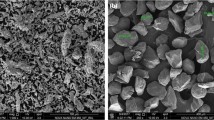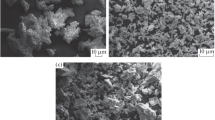As the world is shifting towards renewable sources of energy, the demand for copper is increasing due to its excellent electrical and corrosion resistance properties. Although, because of low strength and wear resistance, the use of pure copper is quite limited. Various reinforcing materials are added to the Cu matrix to fabricate high-strength and wear-resistant copper matrix composites. Powder metallurgy is the most commonly used metal matrix composite fabrication method for Cu-based materials. Properties of a powder metallurgy product depend on the process parameters such as compaction pressure, sintering temperature, sintering time, type and rate of reinforcement, size of matrix and reinforcing elements, etc. In the present work, the influence of the above-mentioned parameters on mechanical and electrical properties of copper-based materials produced by the powder metallurgy method is reviewed in detail. The literature survey revealed that SiC, graphite (Gr), TiC, and graphene (Gn) are the most commonly used reinforcement additives in the Cu matrix for improvement of the strength and wear resistance of Cu-based materials. It has been established that the strength and wear resistance increase after the addition of the mentioned reinforcers, although the electrical conductivity decreases. For enhanced mechanical and electrical properties, a 4–6% weight fraction of micron-sized reinforcers, such as SiC, TiC, and graphite, and a 0.25–1% weight fraction of nano-sized reinforcers, such as CNTs and graphene, are considered the optimum reinforcement range for the Cu-matrix. Small particle size of 3–5 μm of matrix material (Cu) improves mechanical and electrical properties. The size of nano-reinforcers, such as CNTs, should be sufficiently larger (30–50 nm) to avoid agglomeration. Besides, factors contributing to better properties are the optimum range of compaction pressure of 550–650 MPa, sintering temperature of 800–900°C, and sintering time of 60–90 min.







Similar content being viewed by others
References
J. Duan, S. Yuan, C. Zhu, Z. Chen, G. Zhang, H. Duan, L. Li, and Z. Zhu, “One-step synthesis of ZnO/Ndoped carbon/Cu composites for high-performance lithium ion batteries anodes,” Synth. Met., 226, 39–45 (2017).
O. Güler, T. Varol, Ü. Alver, and A. Canakci, “Effect of Al2O3 content and milling time on the properties of silver coated Cu matrix composites fabricated by electroless plating and hot pressing,” Mater. Today Communic., 24, 101–153 (2020).
C. Kim, B. Lim, B. Kim, U. Shim, S. Oh, B. Sung, J. Choi, J. Ki, and S. Baik, “Strengthening of copper matrix composites by nickel-coated single-walled carbon nanotube reinforcements,” Synth. Met., 159, 424–429 (2009).
M. Akbarpour, M. Najafi, S. Alipour, and H. Kim, “Hardness, wear and friction characteristics of nanostructured Cu–SiC nanocomposites fabricated by powder metallurgy route,” Mater. Today Communic., 18, 25–31 (2018).
R. Sule, P. Olubambi, I. Sigalas, J. Asante, J. Garrett, and W. Roos, “Spark plasma sintering of sub-micron copper reinforced with ruthenium–carbon nanotube composites for thermal management applications,” Synth. Met., 202, 123–132 (2015).
D. Miracle, “Metal matrix composites – From science to technological significance,” Comp. Sci. Technol., 65, No. 15–16, 2526–2540 (2005).
D. Kumar, A. Bharti, S.M. Azam, N. Kumar, and H. Tripathi, “Investigations of mechanical properties of copper matrix hybrid composite,” in: B. Biswal, B. Sarkar, P. Mahanta (eds.), Advances in Mechanical Engineering, Lecture Notes in Mechanical Engineering. Springer, Singapore (2020), pp. 671–676; https://doi.org/10.1007/978-981-15-0124-1_60.
N.S. Kumar, R. Suresh, and G.S. Shankar, “High temperature wear behavior of Al2219/n-B4C/MoS2 hybrid metal matrix composites,” Comp. Communic., 19, 61–73 (2020).
B.C. Kandpal, “Production technologies of metal matrix: A review,” IJRMET, 4, No. 2, 27–32 (2014).
G.R. Cabriales, A.L. Sánchez, J.G. Tello, H.M. Prieto, E.G. Castañeda, I.E. Guel, C.G. Reyes , J.H. Rivera, J.C. Rivera, M.M. Orozco, and R.M. Sánchez, “Synthesis and characterization of Al–Cu–Mg system reinforced with tungsten carbide through powder metallurgy,” Mater. Today Communic., 22, 100758 (2019).
Y.B. Lai, S.C. Lim, L. Lu, and M.O. Lai, “Recent development in the fabrication of metal matrixparticulate composites using powder metallurgy techniques,” J. Mater. Sci., 29, 1999–2007 (1994).
J.W. Kaczmar, “The production and application of metal matrix composite materials,” J. Mater. Proc. Technol., 106, No. 1, 58–67 (2000).
N. Kumar, A. Bharti, and H. Tripathi, “Investigation of microstructural and mechanical properties of magnesium matrix hybrid composite,” in: B. Biswal, B. Sarkar, P. Mahanta (eds.). Advances in Mechanical Engineering. Lecture Notes in Mechanical Engineering. Springer, Singapore. (2020), pp. 661–669; https://doi.org/10.1007/978-981-15-0124-1_59.
M. Dixit and R.K. Srivastava, “Effect of compaction pressure on microstructure, density and hardness of Copper prepared by Powder Metallurgy route,” IOP Conf. Series: Mater. Sci. Eng., 377, 012209 (2018).
T.J. Durai, M. Sivapragash, and M.E. Sahayaraj, “Effect of sintering temperature on mechanical properties of Mg–Zr alloy,” Int. J. Mech. Produc. Eng. Research and Development, 7, No. 5, 117–122 (2017).
I. Gunes, T. Uygunoglu, and M. Erdogan, “Effect of sintering duration on some properties of pure magnesium,” Powder Metallurgy and Metal Ceramics., 54, 156–165 (2015).
N. Kumar, A. Bharti, and K.K. Saxena, “A re-analysis of effect of various process parameters on the mechanical properties of Mg based MMCs fabricated by powder metallurgy technique,” Mater. Today: Proceedings, 26, Part. 2, 1953–1959 (2020).
S. Buytoz, F. Dagdelen, S. Islak, M. Kok, D. Kir, and E. Ercan, “Effect of the TiC content on microstructure and thermal properties of Cu–TiC composites prepared by powder metallurgy,” J. Therm. Anal. Calorim., 117, 1277–1283 (2014).
Y. Lin, H. Li, S. Liou, and M. Shie, “Mechanism of plastic deformation of powder metallurgy metal matrix composites of Cu–Sn/SiC and 6061/SiC under compressive stress,” Mater. Sci. Eng. A, 373, 363–369 (2004).
G. Zhang, H. Yin, C. Zhang, Z. Deng, R. Zhang, X. Jiang, and X. Qu, “Effect of Mn on microstructure and properties of Cu–12Al powder metallurgy alloy,” Mater. Research Express, 7, 016546 (2020).
G.A. Gohar, T. Manzoor, A. Ahmad, H. Raza, A. Farooq, I. Karim, W. Iftikhar, M. Umar, and F. Asad, “Synthesis and investigate the properties of Cu–Al–Ni alloys with Ag addition using powder metallurgy technique,” J. Alloys Compd., 817. P. 153281 (2019).
M. Dixit and R. Srivastava, “The effect of copper granules on interfacial bonding and properties of the copper-graphite composite prepared by flake powder metallurgy,” Adv. Powder Technol., 30, No. 12, 3067–3078 (2019).
N.V. Ponraj, A. Azhagurajan, S.C. Vettivel, X.S. Shajan, and P.Y. Nabhiraj, “Study of processing and microstructure of copper composite reinforced with graphene nanosheet by powder metallurgy technique,” Powder Metall. Met. Ceramics, 56, 523–534 (2018).
T. Varo and A. Canakci, “Microstructure, electrical conductivity and hardness of multilayer graphene/copper nanocomposites synthesized by flake powder metallurgy,” Met. Mater. Int., 21, 704–712 (2015).
M. Akbarpour, H.M. Mirabad, S. Alipour, and H. Kim, “Enhanced tensile properties and electrical conductivity of Cu–CNT nanocomposites processed via the combination of flake powder metallurgy and high pressure torsion methods,” Mater. Sci. Eng. A, 773, 138888 (2020).
E. Xu, J. Huang, Y. Li, Z. Zhu, M. Cheng, D. Li, H. Zhong, J. Liu, and Y. Jiang, “Graphite cluster/copperbased powder metallurgy composite for pantograph slider with well-behaved mechanical and wear performance,” Powder Technol., 344, 541–560 (2018).
T. Varol and A. Canakci, “The effect of type and ratio of reinforcement on the synthesis and characterization Cu-based nanocomposites by flake powder metallurgy,” J. Alloys Compd., 649. 1066–1074 (2015).
S.M. Uddin, T. Mahmud, C. Wolf, C. Glanz, I. Kolaric, C. Volkmer, H. Holler, U. Wienecke , S. Roth, and H.J. Fecht, “Effect of size and shape of metal particles to improve hardness and electrical properties of carbon nanotube reinforced copper and copper alloy composites,” Comp. Sci. Technol., 70, 2253–2257 (2010).
R.V. Babu and S. Kanagaraj, “Thermal, electrical and mechanical characterization of microwave sintered Copper/Carbon nanotubes (CNT) composites against sintering duration, CNT diameter and its concentration,” J. Mater. Proc. Technol. 258, 296–309 (2018).
M. Yusoff and Z. Hussain, “Effect of compaction pressure on microstructure and properties of copperbased composite prepared by mechanical alloying and powder metallurgy,” Adv. Mater. Research., 795, 343–346 (2013).
S. Islak, D. Kir, and S. Buytoz, “Effect of sintering temperature on electrical and microstructure properties of hot pressed Cu–TiC composites,” Sci. Sinter., 2014. Vol. 46. P. 15–21.
V.T. Pham, H.T. Bui, B.T. Tran, V.T. Nguyen, D.Q. Le, X.T. Than, V.C. Nguyen, D.P. Doan, and N.M. Phan, “The effect of sintering temperature on the mechanical properties of a Cu/CNT nanocomposite prepared via a powder metallurgy method,” Adv. Nat. Sci.: Nanosci. Nanotechnol., 2, No. 1, 015006 (2011).
M. Yusoff and Z. Hussain, “Effect of sintering parameters on microstructure and properties of mechanically alloyed copper–tungsten carbide composite,” Int. J. Mater., Mechan. Manufact., 1, No. 3, 283–286 (2013).
Author information
Authors and Affiliations
Corresponding author
Additional information
Published in Poroshkova Metallurgiya, Vol. 59, Nos. 7–8 (534), pp. 57–68, 2020.
Rights and permissions
About this article
Cite this article
Kumar, N., Bharti, A., Dixit, M. et al. Effect of Powder Metallurgy Process and its Parameters on the Mechanical and Electrical Properties of Copper-Based Materials: Literature Review. Powder Metall Met Ceram 59, 401–410 (2020). https://doi.org/10.1007/s11106-020-00174-1
Received:
Published:
Issue Date:
DOI: https://doi.org/10.1007/s11106-020-00174-1




